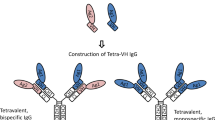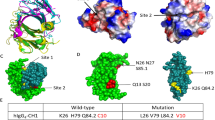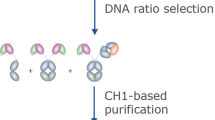Abstract
We have produced novel bispecific antibodies by fusing the DNA encoding a single chain antibody (ScFv) after the C terminus (CH3-ScFv) or after the hinge (Hinge-ScFv) with an antibody of a different specificity. The fusion protein is expressed by gene transfection in the context of a murine variable region. Transfectomas secrete a homogeneous population of the recombinant antibody with two different specificities, one at the N terminus (anti-dextran) and one at the C terminus (anti-dansyl). The CH3-ScFv antibody, which maintains the constant region of human lgG3, has some of the associated effector functions such as long half-life and Fc receptor binding. The Hinge-ScFv antibody which lacks the CH2 and CH3 domains has no known effector functions.
This is a preview of subscription content, access via your institution
Access options
Subscribe to this journal
Receive 12 print issues and online access
$209.00 per year
only $17.42 per issue
Buy this article
- Purchase on Springer Link
- Instant access to full article PDF
Prices may be subject to local taxes which are calculated during checkout
Similar content being viewed by others
References
Flavell, D.J., Cooper, S., Morland, B. and Flavell, S.U. 1991. Characteristics and performance of a bispecific F (ab′gamma)2 antibody for delivering saporin to a CD7+ human acute T-cell leukaemia cell line. Br. J. Cancer 64: 274–280.
Runge, M.S., Bode, C., Savard, C.E., Matsueda, G.R. and Haber, E. 1990. Antibody-directed fibrinolysis: a bispecific (Fab′)2 that binds to fibrin and tissue plasminogen activator. Bioconjug. Chem. 1: 274–277.
Raso, V. and Griffin, T. 1981. Hybrid antibodies with dual specificity for the delivery of ricin to immunoglobulin-bearing target cells. Cancer Res. 41: 2073–2078.
Glennie, M.J., McBride, H.M., Worth, A.T. and Stevenson, G.T. 1987. Preparation and performance of bispecific F(ab′ gamma)2 antibody containing thioether-linked Fab′ gamma fragments. J. Immunol. 139: 2367–2375.
Glennie, M.J., Brennand, D.M., Bryden, F., McBride, H.M., Stirpe, F., Worth, A.T. and Stevenson, G.T., 1988. F(ab′ gamma)2 antibody for the delivery of saporin in the treatment of lymphoma. J. Immunol. 141: 3662–3670.
Reading, C., 1983. Bifunctional Antibodies, pp. 235 in Hybridomas and Cellular Immortality. Press, P. (ed.). Plenum Press: New York.
Martinis, J., Franz, K.J.F. and Bartholomew, R. 1982. Proceedings of the Thirteenth Colloquium on Protides of the Biological Fluids. Peter, H.E. (ed.). New York: Pergamon Press. 311.
Milstein, C. and Cuello, A.C. 1983. Hybrid hybridomas and their use in immuno-histochemistry. Nature 305: 537–540.
Kontsekova, E., Kolcunova, A. and Kontsek, P. 1992. Quadroma-secreted bi(interferon alpha 2—peroxidase) specific antibody suitable for one-step immunoassay. Hybridoma 11: 461–468.
Lloyd, F.J. and Goldrosen, M. 1991. The production of a bispecific anti-CEA, anti-hapten (4-amino-phthalate) hybrid-hybridoma. J. Natl. Med. Assoc. 83: 901–904.
Tada, H., Kurokawa, T., Seita, T., Watanabe, T. and Iwasa, S. 1994. Expression and characterization of a chimeric bispecific antibody against fibrin and against urokinase-type plasminogen activator. J. Biotechnol. 33: 157–174.
Pack, P. and Pluckthun, A. 1992. Miniantibodies: use of amphipathic helices to produce functional, flexibly linked dimeric FV fragments with high avidity in Escherichia coli. Biochemistry 31: 1579–1584.
George, A.J., Titus, J.A., Jost, C.R., Kurucz, I., Perez, R., Andrew, S.M., Nicholls, P.J., Huston, J.S. and Segal, D.M. 1994. Redirection of T cell-mediated cyto-toxicity by a recombinant single-chain Fv molecule. J. Immunol. 152: 1802–1811.
Chaudhary, V.K., Batra, J.K., Gallo, M.G., Willingham, M.C., FitzGerald, D.J. and Pastan, I. 1990. A rapid method of cloning functional variable-region antibody genes in Escherichia coli as single-chain immunotoxins [published erratum appears in Proc .Nat. Acad. Sci. USA 1990 Apr;87(8):3253]. Proc. Natl. Acad. Sci. USA 87: 1066–1070.
Ayala, M., Duenas, M., Santos, A., Vazquez, J., Menendez, A., Silva, A. and Gavilondo, J.V. 1992. Bacterial single-chain antibody fragments, specific for carcinoembryonic antigen. Biotechniques 13: 790–799.
Tao, M.H., Canfield, S.M. and Morrison, S.L. 1991. The differential ability of human lgG1 and lgG4 to activate complement is determined by the COOH-terminal sequence of the CH2 domain. J. Exp. Med. 173: 1025–1028.
Huston, J.S., Levinson, D., Mudgett, H.M., Tai, M.S., Novotny, J., Margolies, M.N., Ridge, R.J., Bruccoleri, R.E., Haber, E., Crea, R. et al. 1989. Protein engineering of antibody binding sites: recovery of specific activity in an anti-digoxin single-chain Fv analogue produced in Escherichia coli. Gene 77: 51–59.
Ayala, M., Balint, R.F., Fernandez, de, Cossio, L., Canaan, H.J., Larrick, J.W., and Gavilondo, J.V. 1995. Variable region sequence modulates periplasmic export of a single-chain Fv antibody fragment in Escherichia coli. Biotechniques 18: 835–838.
Wallick, S.C., Kabat, E.A. and Morrison, S.L. 1988. Glycosylation of a VH residue of a monoclonal antibody against alpha (1—>;6) dextran increases its affinity for antigen. J. Immunol. 141: 3516–3522.
Tao, M.H. and Morrison, S.L. 1989. Studies of aglycosylated chimeric mouse-human IgG. Role of carbohydrate in the structure and effector functions mediated by the human IgG constant region. J. Immunol. 143: 2595–2601.
Kirn, J.K., Tsen, M.F., Ghetie, V. and Ward, E.S. 1994. Identifying amino acid residues that influence plasma clearance of murine lgG1 fragments by site-directed mutagenesis. Eur. J. Immunol. 24: 542–548.
Kim, J.K., Tsen, M.F., Ghetie, V. and Ward, E.S. 1994. Catabolism of the murine lgG1 molecule: evidence that both CH2-CH3 domain interfaces are required for persistence of lgG1 in the circulation of mice. Scand. J. Immunol. 40: 457–465.
Kim, J.K., Tsen, M.F., Ghetie, V. and Ward, E.S. 1995. Evidence that the hinge region plays a role in maintaining serum levels of the murine lgG1 molecule. Mol. Immunol. 32: 467–475.
Duncan, A.R. and Winter, G. 1988. The binding site for C1q on IgG. Nature 332: 738–740.
Tao, M.H., Smith, R.I. and Morrison, S.L. 1993. Structural features of human immunoglobulin G that determine isotype-specific differences in complement activation. J. Exp. Med. 178: 661–667.
Duncan, A.R. and Winter, G. 1994. The binding site for C1q on IgG. J. Exp. Med. 180: 1087–1096.
Duncan, A.R., Woof, J.M., Partridge, L.J., Burton, D.R. and Winter, G. 1988. Localization of the binding site for the human high-affinity Fc receptor on IgG. Nature 332: 738–740.
Canfield, S.M. and Morrison, S.L. 1991. The binding affinity of human IgG for its high affinity Fc receptor is determined by multiple amino acids in the CH2 domain and is modulated by the hinge region. J. Exp. Med. 173: 1483–1491.
Chappel, M.S., Isenman, D.E., Everett, M., Xu, Y.Y., Dorrington, K.J. and Klein, M.H. 1991. Identification of the Fc gamma receptor class I binding site in human IgG through the use of recombinant lgG1/lgG2 hybrid and point-mutated antibodies. Proc. Natl. Acad. Sci. USA 88: 9036–9040.
Dangl, J.L., Parks, D.R., Oi, V.T. and Herzenberg, L.A. 1982. Rapid isolation of cloned isotype switch variants using fluorescence activated cell sorting. Cytometry 2: 395–401.
Ho, S.N., Hunt, H.D., Norton, R.M., Pullen, J.K. and Pease, L.R. 1989. Site-directed mutagenesis by overlap extension using the polymerase chain reaction. Gene 77: 51–59.
Horton, R.M., Ho, S.N., Pullen, J.K., Hunt, H.D., Cai, Z. and Pease, L.R. 1993. Gene splicing by overlap extension. Methods Enzymol. 217: 270–279.
Holton, T.A. and Graham, M.W. 1991. A simple and efficient method for direct cloning of PCR products using ddT-tailed vectors. Nucleic Acids Res. 19.
Shin, S.U., Wright, A., Bonagura, V., and Morrison, S.L. 1992. Genetically-engineered antibodies: tools for the study of diverse properties of the antibody molecule. Immunol. Rev. 130: 87–107.
Wright, A., Shin, S.U. and Morrison, S.L. 1992. Genetically engineered antibodies: progress and prospects. Crit. Rev. Immunol. 12: 125–168.
Shin, S.U. and Morrison, S.L. 1989. Production and properties of chimeric antibody molecules. Methods Enzymol. 178: 459–476.
Nieto, A., Gaya, A., Jansa, M., Moreno, C. and Vives, J. 1984. Direct measurement of antibody affinity distribution by hapten-inhibition enzyme immunoassay. Mol. Immunol. 21: 537–543.
Wright, A. and Morrison, S.L. 1994. Effect of altered CH2-associated carbohydrate structure on the functional properties and in vivo fate of chimeric mouse-human immunoglobulin G1. J. Exp. Med. 180: 1087–1096.
Smith, R.I. and Morrison, S.L. 1994. Recombinant polymeric IgG: an approach to engineering more potent antibodies. Bio-Technology 12: 683–688.
Author information
Authors and Affiliations
Rights and permissions
About this article
Cite this article
Coloma, M., Morrison, S. Design and production of novel tetravalent bispecific antibodies. Nat Biotechnol 15, 159–163 (1997). https://doi.org/10.1038/nbt0297-159
Received:
Accepted:
Issue Date:
DOI: https://doi.org/10.1038/nbt0297-159
This article is cited by
-
Target delivery of a PD-1-TREM2 scFv by CAR-T cells enhances anti-tumor efficacy in colorectal cancer
Molecular Cancer (2023)
-
Directing HIV-1 for degradation by non-target cells, using bi-specific single-chain llama antibodies
Scientific Reports (2022)
-
Development of CDX-527: a bispecific antibody combining PD-1 blockade and CD27 costimulation for cancer immunotherapy
Cancer Immunology, Immunotherapy (2020)
-
Bispecific antibodies: a mechanistic review of the pipeline
Nature Reviews Drug Discovery (2019)
-
mRNA as novel technology for passive immunotherapy
Cellular and Molecular Life Sciences (2019)



